Life came full circle for Robert Stephen Hawker in Plymouth where he was born on the 3rd of December in 1804 and baptised in Stoke Damerel parish church. His father Jacob worked in medicine and his grandfather Dr Robert Hawker was the vicar of Charles Church.
Robert died on the 15th of August in 1975, having converted from the Anglican Church to Catholicism on his deathbed, in Plymouth. He was laid to rest in Ford Park Cemetery with his second wife Pauline. Mourners wore purple, not traditional black, when they paid their respects at his funeral.
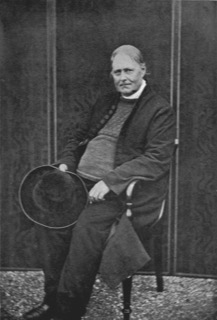 Of his interesting life, Hawker himself wrote: "What a life mine would be if it were all written and published in a book."
Of his interesting life, Hawker himself wrote: "What a life mine would be if it were all written and published in a book." He is best known as the eccentric parson of Morwenstow who gave Christian burials to sailors who drowned from ship wrecks along the rocky North Cornish coast. It is thought that he turned a blind eye to the activities of “wreckers” who lured ships onto the rocks so that they could salvage the cargo when washed ashore because it provided income and sought after items for the poor rural community.
Rev Hawker is said to have introduced the “Harvest Festival” and is best known as the author of a rousing song called “The Song of the Western Men” or “Trelawney.”
It was first published as a poem in 1826 in the Plymouth Chronicle and the Royal Devonport Telegraph. As a song it is popular to this day and regarded informally as the anthem for Cornwall with the chorus line:
“And shall Trelawney live, and shall Trelawney die, here’s 20,000 Cornish men will know the reason why.”
Many poems and letters were written by Rev Hawker in a hut built from driftwood perched on the cliffs near Morwenstow Church. “Hawker’s Hut” is the smallest property owned by the National Trust.
After his first wife Charlotte died in 1863, Rev Hawker married again and was 60 years old when he married 20 year old Pauline Kuczynski. They had three daughters, Morwenna, Rosalind and Juliet, before Rev Hawker died at the age of 71.
- The final resting place for Rev Hawker can be easily found with its large granite cross. If you walk from the Chapel office towards the nearest gate to Ford Park Road you will see the grave on the left from where you are standing on the main path/vehicular route.
A tree synonymous with old church yards and cemeteries in the United Kingdom is Taxus bachata or the Yew. Ford Park Cemetery has some magnificent Yews especially in the historic quarter in front of the chapels.
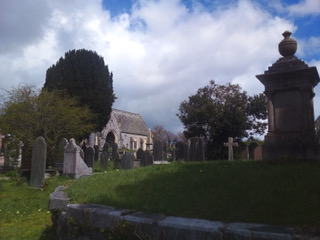
This evergreen conifer which can grow up to 20 metres (65 feet) tall has soft straight needle-shaped green leaves and red berry-like fruits called Aril, popular with birds and small mammals, such as squirrels. The very dark and upright form of the Yew was popular in Victorian cemeteries to represent the sombre shades of grief and to stand like sentinels to ward off evil spirits.
But every part of this tree is highly poisonous to people and larger animals which is why it’s said the Yew was originally planted in church yards to deter farmers from letting their sheep or cattle wander on to church land to graze.
The wood from the Yew is extremely strong and resistant to breaking which made it perfect material to make longbows. Indeed the fatal arrow which killed the Anglo-Saxon King Harold Godwinson in the Battle of Hastings of 1066 was fired from a yew longbow. Though its popularity as the material to make these weapons resulted in a severe depletion of this tree population in Europe.
The Yew was said to be sacred to Hecate, the Greek goddess associated with death, witchcraft and magic.
The Yew can also symbolise renewal because of its ability to regenerate new trunks on the spot where the low hanging branches make contact with the earth. Likewise in Celtic culture this plant symbolised death and resurrection, the Druids regarded the Yew as sacred, and in Christianity times the deceased would be buried with yew branches.
Symbolically this tree represented immortality and everlasting life because of its astonishing longevity in excess of 3,000 years; though this might be challenging to evidence because of the absence of rings to establish the age in the hollow trunks.
Many ancient yews have hollow trunks, and one magnificent example stands in the grounds of the Parish Church of St Andrew in Kenn, near the Devon city of Exeter. The male Yew is said to be older than Christianity itself and pre-dates the Norman font within the Grade I listed red sandstone church.
Ford Park Cemetery Trust would like to express its sincere thanks and appreciation to Plymouth funeral directors for their participation in a survey about the quality of its services for the bereaved.
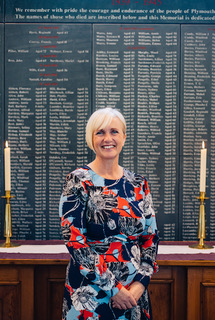 Every one of the 14 funeral directors from eight companies gave top marks for the support they receive from our cemetery office and grounds maintenance staff.
Every one of the 14 funeral directors from eight companies gave top marks for the support they receive from our cemetery office and grounds maintenance staff. The survey, conducted in February 2023, captured constructive feedback on funeral-related services provided by Ford Park Cemetery including the Victorian Chapel, graveside committals and interment of cremated remains, vehicular access and on site parking; wake receptions, the upkeep of the cemetery grounds and overall value for money.
Funeral directors expressed their high regard for the simplicity, ambience and acoustics of the Victorian Chapel and not feeling rushed with unlimited time in the chapel for services.
The Trust Board intends to explore suggestions from survey feedback to inform future service improvement.
Trustee Wendy Coulton (pictured) said: “It was heartening to hear the genuine high regard there is for Ford Park Cemetery and how well it serves the funeral professionals and the local community.
‘There have been significant changes in the expectations and needs of the bereaved over the past decade in terms of how and where they wish to pay their respects and honour the memory of loved ones. The Trust Board wants to ensure that Ford Park Cemetery continues to be valued and used by local people for generations to come.
“A lot of time, care and energy is put into the running of this cemetery with a significant amount of fundraising required to meet rising overheads. This is achieved primarily through our funeral-related services, our grave maintenance contracts and the wonderful efforts of our award winning volunteers and Friends group.”
When you see a solitary Magpie do you swiftly acknowledge it with a greeting of “Hello Mr Magpie?” or salute it?
Originally this distinctive bird with its predominantly black, white and metallic plumage featured in a well known counting song thought to date back to 1780. Your fate could be predicted by how many magpies you counted…..
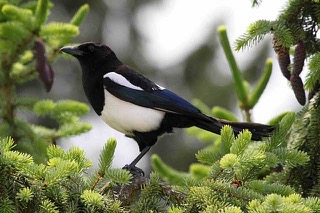
One for sorrow,
Two for joy,
Three for a girl,
Four for a boy,
Five for silver,
Six for gold,
Seven for a secret,
Never to be told.
There are alternative versions of this song and a much simpler early example was
One for sorrow, two for mirth, three for a funeral and four for birth.
These rhymes and the associated superstition are most often about magpies but have been known, particularly in America, to apply to the counting of other members of the Corvid family - jackdaws, ravens and crows.
Similar superstitions are connected with black coloured birds such as Ravens being a sign of bad luck. The association made with death has been linked with the strong sense of smell a Raven possesses, drawing it to decaying flesh.
Magpies are also not popular because of their reputation for being thieves - stealing eggs from the nests of other birds and taking anything they come across which is shiny, such as jewellery.
Magpies were regarded as a symbol of vanity and the Scots historically believed they were an evil bird which carries the devil’s blood under its tongue.
Country folk in bygone days would carry onions to ward off the bad luck they feared would fall upon them at the sight of a magpie and the French thought Magpies were reincarnated evil nuns! But in China and Korea they are welcomed as a good omen bringing positive news and tidings.
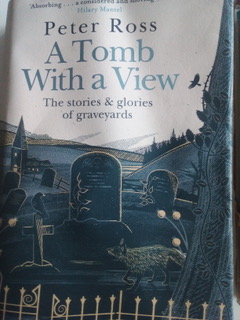 Book Recommendation:
Book Recommendation:
A tomb with a view - the stories and glories of graveyards
Regular visitors and supporters of Ford Park Cemetery will appreciate the research and engaging way award winning author Peter Ross reveals the fascinating human stories abundant in cemeteries.
During the Covid pandemic lockdown, the cemetery behind Peter’s home became a place of refuge for him and the inspiration for the book. Chapters are dedicated to a diverse range of topics from angels, ivy and anchors to un-marked graves and individual life and death stories.
It is thought provoking, interesting and strangely uplifting with respectful humour.


